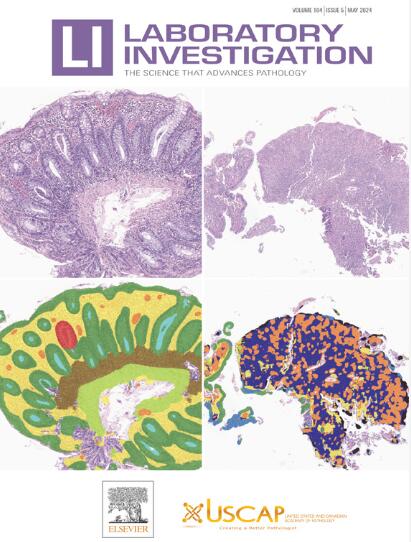前列腺癌中PARP1和PARP2拷贝数改变的预后价值
IF 5.1
2区 医学
Q1 MEDICINE, RESEARCH & EXPERIMENTAL
引用次数: 0
摘要
PARP1/2在DNA修复和雄激素受体转录调控中具有重叠但不冗余的生物学功能。人类肿瘤中PARP改变的研究产生了相互矛盾的结果。在前列腺癌(PCa)中,PARP1/2蛋白过表达与雄激素剥夺治疗抵抗、生化复发和转移进展有关。PARP抑制剂已被批准用于治疗转移性去势耐药PCa同源重组修复基因突变。然而,PARP1/2基因组改变的意义尚未得到充分研究。我们的目的是分析前列腺癌中PARP1/2的改变,评估其作为预后标志物的价值,并探讨其与潜在治疗分层的相关性。应用实时荧光定量PCR技术评估121例PCa原发肿瘤的PARP1/2拷贝数状态。其中29例伴有盆腔局部淋巴结受累。分析24例PCa患者BRCA1/2体细胞突变。评估与临床病理特征、转移进展和前列腺特异性抗原复发的关系。PARP1缺失和PARP2增加分别在34.7%和32.2%的原发肿瘤中检测到,且共发频率高(P <;措施)。两种改变在诊断时均与局部晚期疾病相关(P = 0.036;P = 0.006),转移性传播(P = 0.014;P = 0.003),以及其他侵袭性临床病理特征(如Gleason 5型、高级别和高分期的存在)。单纯PARP2获得的患者前列腺特异性抗原复发时间最短,而双wt患者预后最佳(P = 0.007)。在29例配对原发肿瘤和局部盆腔淋巴结受累中,PARP1缺失表现出很强的一致性(P = .001),而PARP2缺失则没有(P = .411)。总之,PARP1的缺失和PARP2的获得表现出很强的共现性,并与侵袭性的临床病理特征相关。PARP2的改变似乎对疾病预后有特别显著的影响。此外,这些数据表明,分析PARP1/2拷贝数状态可能有助于预测PCa的结果。其在治疗中的作用有待进一步评估。本文章由计算机程序翻译,如有差异,请以英文原文为准。
Prognostic Value of PARP1 and PARP2 Copy Number Alterations in Prostate Cancer
PARP1/2 have overlapping yet nonredundant biological functions in DNA repair and androgen receptor-transcriptional regulation. Studies on PARP alterations in human tumors have yielded conflicting results. In prostate cancer (PCa), PARP1/2 protein overexpression has been related to androgen deprivation therapy resistance, biochemical recurrence, and progression to metastases. PARP inhibitors have been approved for treating metastatic castration-resistant PCa with homologous recombination repair gene mutations. However, the significance of PARP1/2 genomic alterations is not fully studied. We aimed to analyze PARP1/2 alterations in PCa, assess their value as prognostic markers, and explore their relevance for potential therapeutic stratification. PARP1/2 copy number status was evaluated in 121 PCa primary tumors using real-time PCR. In 29 of them, a regional pelvic lymph node involvement was also analyzed. BRCA1/2 somatic mutations were analyzed in 24 PCa cases. Relationship with clinicopathological features, progression to metastases, and prostate-specific antigen recurrence was assessed. PARP1 loss and PARP2 gain were detected in 34.7% and 32.2% of primary tumors, respectively, with a high frequency of co-occurrence (P < .001). Both alterations were statistically associated with locally advanced disease at the time of diagnosis (P = .036; P = .006), metastatic dissemination (P = .014; P = .003), and other aggressive clinicopathological characteristics (such as the presence of Gleason pattern 5, high-grade, and high-stage). Cases with exclusive PARP2 gain had the shortest time to prostate-specific antigen recurrence, whereas double wt patients displayed the best outcome (P = .007). In 29 paired primary tumors and regional pelvic lymph node involvement, PARP1 loss showed strong concordance (P = .001), whereas PARP2 gain did not (P = .411). In conclusion, loss of PARP1 and gain of PARP2 show strong co-occurrence and are associated with clinicopathological characteristics of aggressiveness. PARP2 alterations appear to have a particularly significant impact on disease prognosis. Furthermore, these data suggest that the analysis of PARP1/2 copy number status could be useful in predicting PCa outcomes. Its role in therapy warrants further evaluation.
求助全文
通过发布文献求助,成功后即可免费获取论文全文。
去求助
来源期刊

Laboratory Investigation
医学-病理学
CiteScore
8.30
自引率
0.00%
发文量
125
审稿时长
2 months
期刊介绍:
Laboratory Investigation is an international journal owned by the United States and Canadian Academy of Pathology. Laboratory Investigation offers prompt publication of high-quality original research in all biomedical disciplines relating to the understanding of human disease and the application of new methods to the diagnosis of disease. Both human and experimental studies are welcome.
 求助内容:
求助内容: 应助结果提醒方式:
应助结果提醒方式:


